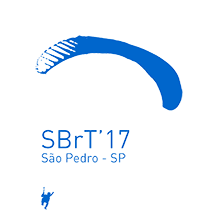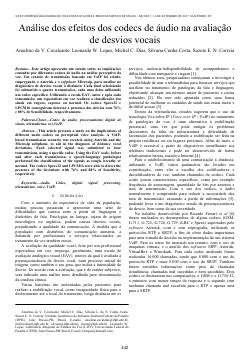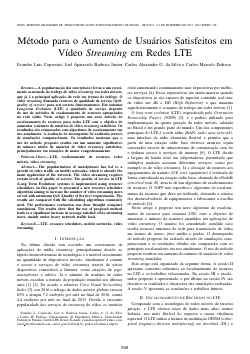
XXXV Simpósio Brasileiro de Telecomunicações e Processamento de Sinais

Ressonância Estocástica na Quantização
Thales H. A. Resende, Leonardo C. Araújo, João P. H. Sansão
DOI: 10.14209/sbrt.2017.231
Keywords: quantização ressonância estocástica com supralimiar quantização estocástica.
Abstract
O presente estudo aborda o processo da quantização estocástica utilizando o fenômeno conhecido como ressonância estocástica. Neste trabalho foram realizadas simulações da quantização estocástica aplicada a imagens de um banco de dados. Verifica-se que o sistema possui melhor desempenho para uma SNR de entrada intermediária, corroborando o modelo apresentado por McDonnell.Download

Pareamento de subportadoras, alocação de potência e seleção de modo em redes cooperativas OFDM
Eloise de Carvalho Rodrigues, Alexandre Matos Pessoa, Francisco Rafael M. Lima, Tarcı́sio F. Maciel, Francisco Rodrigo P. Cavalcanti
DOI: 10.14209/sbrt.2017.59
Keywords: Subcarrier pairing power allocation mode selec- tion cooperative systems
Abstract
The fourth generation of mobile communications provides many benefits such as high transmit data rates, low transmit power consumption and reduced latency. Cooperative communication consists in a key concept to those systems that allows the achievement of gains in transmit data rates and reliability. The potential of cooperative communications can be better exploited when this technology is used joinlty with radio resource allocation strategies. In this work we formulate the data rate maximization problem that takes into account subcarrier pairing of OFDM (Orthogonal Frequency Division Multiplexing) subcarriers, transmit power allocation and transmit mode se- lection (with or without diversity in the receiver). Besides, we also consider a realistic link adaptation model that maps SNR (Signal-to-Noise Ratio) in transmit data rate.Download

Tensor-Based Multiuser Detection for Uplink DS-CDMA Systems with Cooperative Diversity
Antonio Augusto Teixeira Peixoto, Carlos Alexandre Rolim Fernandes
DOI: 10.14209/sbrt.2017.45
Keywords: Semi-blind receiver DS-CDMA Cooperative com- munications PARAFAC Tensor model Alternating least squares
Abstract
In the present paper, a semi-blind receiver for a multiuser uplink DS-CDMA (Direct-Sequence Code-Division Multiple-Access) system based on relay aided cooperative com- munications is proposed. For the received signal, a quadrilinear Parallel Factor (PARAFAC) tensor decomposition is adopted, such that the proposed receiver can semi-blindly estimate the transmitted symbols, channel gains and spatial signatures of all users. The estimation is done by fitting the tensor model using the Alternating Least Squares (ALS) algorithm. With computa- tional simulations, we provide the performance evaluation of the proposed receiver for various scenarios.Download

Algoritmos Genéticos Aplicados para Otimização dos Parâmetros de um Reconhecedor Automático de Fala
Enio dos Santos Silva, Alberto Luiz Wiggers
DOI: 10.14209/sbrt.2017.60
Keywords: Genetic algorithms Julius decoder automatic speech recognition parameters optimization
Abstract
State-of-the-art automatic speech recognition (ASR) systems are comprised of complex decoders that have a large number of parameters that allow tuning for performance and speed. These parameters are often optimized manually, based on past experience and specialist knowledge. Speci cally, to reach optimal performance, deep understanding of each decoder parameter is necessary, as well as an understanding about the tradeo between accuracy word rate (AWR) and real time factor (RTF). In order to nd the optimal decoding parameters without an manual tuning, this paper presents a strategy that automatically tunes the Julius decoder parameters, used as engine in an ASR system. Particularly, the proposed strategy uses genetic algorithms to reach an optimal tune by evaluation of a cost function involving AWR and RTF. The obtained results of AWR and RTF are presented con rming the e ectiveness of the proposed strategy.Download

Performance Analysis of Resource Unit Configurations for M2M Traffic in the Narrowband-IoT System
Renato Caminha Juaçaba Neto, Emanuel Bezerra Rodrigues, Carina Teixeira de Oliveira
DOI: 10.14209/sbrt.2017.61
Keywords: M2M LTE NB-IoT Performance Evaluation Up- link Schedulers
Abstract
The massive amount of low-end uplink traffic of Machine to Machine (M2M) communications are a key aspect of what 5G will be. In this context, Narrowband-IoT (NB-IoT) is described as the next step to allow Long Term Evolution (LTE) support for this type of traffic. This new technology provides support to massive amounts of ultra-low-end devices while occupying the frequency space of a single LTE resource block. This work studies the NB-IoT uplink, which allows multi- tone and single-tone transmissions. These types of transmissions result in configurations of resource units for NB-IoT devices that have different durations and frequency occupations. We present extensive simulations results that provide insight into the behavior of the configurations. Based on these simulations, we discuss the best resource configurations to be used by NB-IoT. We also defend the feasibility of NB-IoT for higher tier traffic.Download

On the Effects of Decoupling and Matching Networks in Phase Array Radiation Patterns for Radar Applications
Mariana Pralon, Reiner Thomä, Bruno Pompeo, Gabriel Beltrao, Leandro Pralon
DOI: 10.14209/sbrt.2017.62
Keywords: phased array radar decoupling matching com- pact antenna arrays decoupling networks
Abstract
Phased array systems employ a set of properly cho- sen radiating elements, geometrically configured and strategically excited in order to render a specific radiation pattern, best suited for a given application. When the total antenna size emerges as an application constraint, both size of the radiating elements as well as the distance between them need to be optimized. If the spacing between neighboring elements reduces to less than half of the free-space wavelength, electromagnetic coupling becomes stronger. The consequences are the following: the radiation pat- terns are distorted, the antenna ports become mismatched, and the effective degrees of freedom (DoF) are reduced. To overcome the degrading effects that strong electromagnetic coupling may bring to phased array radars, transmission lines are designed with the purpose of decoupling and matching the excitation ports. Within this context, this paper investigates the effects of an eigenmode based decoupling technique in phase array radiation patterns for Radar applications.Download

Melhora da resposta de antenas miniaturizadas com polarização circular á direita
J. A. Nascimento, L. R. Silva, J. M. Gurgel Neto, A. A. P. Silva, R. M. Lima Neta, A. Neves Rocha
DOI: 10.14209/sbrt.2017.65
Keywords: polarization microstrip circular
Abstract
The goal of the paper is to increase the response of a miniaturized circularly polarized microfiber antenna, which has been used in previous works to validate a technique for obtaining electromagnetic polarization using an adaptation of the linear component method. Parameters were changed as the type of conductor used, substrate and position of the feed path and the results obtained in the combinations performed were better than that presented in previous works. The work is essentially obtained from simulations carried out in the CST®Download

Análise dos efeitos dos codecs de áudio na avaliação de desvios vocais
Anselmo de V. Cavalcante, Leonardo W. Lopes, Michel C. Dias, Silvana Cunha Costa, Suzete E. N. Correia
DOI: 10.14209/sbrt.2017.64
Keywords: Audio Codec telemedicine voice VoIP digital signal processing
Abstract
This article presents a study on the implications of different audio codecs on perceptual voice analysis. A VoIP- based transmission scenario was created, using Asterisk and the Microsip softphone, to aid in the diagnosis of distance vocal deviations. Each selected signal was submitted to four transmissions, using a specific codec. Using the EAV scale, before and after each transmission, a speech-language pathologist performed the classification of the signals as rough, breathy or normal. The codecs Speex32 and LPCM16 were able to detect the presence of the deviations with 76% and 88% of Sensitivity, respectively.Download

Método para o Aumento de Usuários Satisfeitos em Vídeo Streaming em Redes LTE
Evandro Luis Copercini, Joel Aparecido Barbosa Junior, Carlos Alexandre G. da Silva, Carlos Marcelo Pedroso
DOI: 10.14209/sbrt.2017.63
Keywords: — LTE escalonamento de recursos redes moveis vídeo streaming
Abstract
A popularização dos smartphones levou a um crescimento acentuado do tráfego de vídeo streaming em redes moveis, que já e a principal aplicação da rede em termos de tráfego. O vídeo streaming demanda recursos de qualidade de servic¸o (QoS, quality of service) para seu correto funcionamento. Em sistemas Long-term Evolution (LTE) a qualidade de serviço depende do uso de métodos de escalonamento de recursos apropriados na rede radio. Neste artigo é proposto um novo método de escalonamento de recursos para redes LTE com o objetivo de aumentar o numero de usuários de vídeo streaming satisfeitos. Os resultados são comparados com algoritmos de escalonamento em uso atualmente. A avaliação de desempenho foi realizada através de simulações computacionais. Os resultados mostram que o uso do método proposto resulta em um aumento significativo do numero médio de usuários de vídeo streaming satisfeitos, principalmente em situações de maior congestionamento.Download

Algoritmo de Escalonamento de Pacote com Policiamento de Tráfego para Alocação de Recurso em Redes LTE Downlink
Jeanette Quiñones Ccorimanya, Lee Luan Ling
DOI: 10.14209/sbrt.2017.66
Keywords: Long Term Evolution (LTE) Traffic Policing Packet Scheduler Quality of Service (QoS)
Abstract
In this paper, we improve the performance of packet scheduling in LTE system for multimedia service applications us- ing traffic policing algorithms known as leaky bucket controllers. We achieve fairness between classes of service, the arrival rates of packets to transmission queues of the scheduler. Simulation results show that schedulers with policed input traffic provide better performance for real-time services, specially for video traffic. The performance evaluation was carried out in terms of quality of service parameters, such as average delay, average throughput and packet loss ratio for Video and VoIP traffic.Download